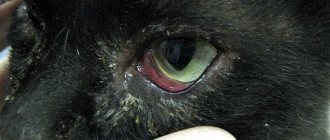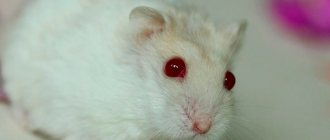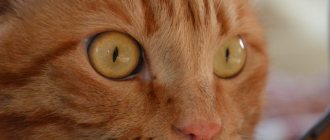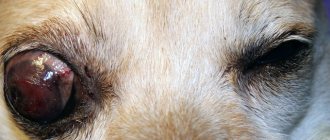A turtle's eyes are the most exposed organs exposed to harmful bacteria living in the water. Eye diseases not only cause discomfort in your pet, but can also lead to blindness. If you notice that your red-eared slider's eyes are swollen, first take the simplest measures to relieve the animal's condition, and then seek help from a veterinarian. October 22, 2014
Author: Lando Anastasia
Eye diseases of red-eared turtles and their symptoms
Main symptoms for eye problems:
- the mucous membrane of the eyes is red;
- swollen eyelids;
- white coating on the eyeballs;
- eyes are closed or completely closed;
- corneal clouding;
- difficulty moving the eyeball.
Associated symptoms: poor coordination of movements, weakness, poor appetite, high fever.
The most common diagnosis made in the presence of the above symptoms is conjunctivitis. This disease is caused by staphylococcus and streptococcus bacteria.
The cause of an infectious disease can be both poor living conditions and poor nutrition.
If a red-eared turtle's eyes are swollen, this may also be a consequence of vitamin deficiency or keeping the amphibian in dirty, stagnant water.
Another turtle eye disease is panophthalmitis . This is a deep purulent inflammation of the tissues of the eyeball. The infection first affects the lower eyelid. Then clouding of the eye occurs. Lack of treatment in this case inevitably leads the turtle to blindness.
Also read the article “How to determine the sex of a red-eared slider”
Diet
If you are experiencing red eyes in your turtle, it may be due to a lack of vitamin A. Fortunately, this is very easy to avoid - after all, this valuable vitamin is contained in a vegetable that is available in every kitchen, without exception. Of course, we are talking about carrots. A few pieces of juicy root vegetables a day will completely satisfy your pet’s need for vitamin A. For eye diseases, you can also give a small amount of liver - no more than once a week.
The usual diet should consist of plant foods. Excellent algae (ludwigia, hornwort, duckweed, ceratopteris) are suitable, which can be grown in a separate aquarium and gradually fed the excess to the turtle. She eats great cabbage and lettuce scalded with boiling water, dandelions, clover, fresh cucumbers and even thinly cut watermelon rinds.
Eye diseases of red-eared turtles - treatment
First of all, the animal must be placed in clean water, since it is the polluted environment that often causes eye diseases in turtles.
Drug treatment consists of the use of drops and antibiotics.
- One of the drugs (“Sofradex”, “Tsiprolet”, “Albucid”, “Tobradex”) is instilled into the pet’s eyes 2 times a day. If the eyelids are tightly closed, then the lower one must be carefully pulled back. The course lasts 5-10 days, depending on the condition of the turtle.
- Panophthalmitis is treated with antibiotics. A course of these medications must be prescribed by a veterinarian, since self-medication with such medications, which are difficult for the turtle, usually leads to death.
- In severe cases, the eyeball is removed.
- It is recommended to accompany the treatment of eye disease in red-eared turtles with the use of veterinary multivitamin complexes: “Intravit”, “Multivit”, “Eleovit”. When purchasing, be sure to read the composition of the drug. It should not contain vitamin D2 as it is poisonous to turtles. Vitamins, on the recommendation of a doctor, can be administered by injection.
- As additional measures to alleviate the condition of the red-eared turtle, use a decoction of chamomile and a solution of boric acid. Moisten a cotton swab with it and remove plaque from your eyes.
- For mild forms of the disease, tetracycline ointment is used externally.
Colds
Have you noticed that the turtle’s eye is swollen, and besides, it coughs, cannot swim normally, and rolls over on its side? Most likely it's pneumonia. Alas, this happens quite often if the owners do not take care of additional heating of the terrarium during the cold season.
You should definitely consult a veterinarian. If this is not possible, you should subject your pet to a course of chamomile inhalation.
The herb is poured with water and brought to a boil. After this, a sieve is placed on the pan (not a plastic or metal one - a regular one, made of threads), the turtle is placed in it, the sieve is covered with a cloth and left for 10 minutes. After this, the slightly cooled water should be diluted with cold water so that the temperature is 30-45 degrees. The turtle can swim calmly in this water or just stand. Finally, the reptile is placed in a suitable container and heated with a lamp to 35 degrees for 4 hours. Such procedures are quite tedious - they need to be repeated twice a day for a week.
It is worse if the turtle suffers from complex rhinitis. The symptoms are very similar to pneumonia, but they include an open mouth (she cannot breathe) and air bubbles coming out of the nose when the pet swims. It is better not to self-medicate - go straight to the veterinarian. He will prescribe suitable antibiotics, which will certainly help the patient.
Frequent pneumonia
If a red-eared turtle coughs, eats poorly, swims sideways, cannot dive and does not open its eyes, it is a 100% cold. The sore is not uncommon, unpleasant, but at the initial stage it is curable even at home. In this case, warm baths and inhalations with chamomile are effective. What does that require:
- Brew a strong decoction of a medicinal plant in a deep saucepan and inhale it as for a person. Your own nasopharynx will be an excellent indicator of temperature. As an option, a hand in which you can hold a suspended turtle is also suitable. The procedure will take at least 10 minutes, so if it’s hard to hold your hand suspended for so long, use a sieve, but not a metal colander. Otherwise, the pet will get burns.
- Upon completion of the inhalation, dilute the chamomile infusion with water to a temperature of 40-45ºC and give your client a bath. It is important that the temperature does not drop below 30ºС. It’s good if a sick pet splashes around in the healing infusion for at least 20-25 minutes.
- Then you need to warm the reptile for four hours in a dry container at a temperature not lower than 35ºC.
Such procedures need to be repeated a couple of times a day until the reptile recovers. Typically, the process takes about a week. But there are also more complex diseases that require a special approach.
What is important to consider
First of all, make sure that the pet is simply not sleeping, because the good vision of the red-eared turtle allows it to stay awake both during the day and at night. Observe her throughout the day. Too much sleep and general lethargy can be warning signs of illness, even if the reptile's eyes are still shiny and wide open. In this case, immediately adjust the conditions of detention. So, the disease can be provoked by:
- Low water temperature;
- Lack or insufficient use of UV lamps and shore heating;
- Unbalanced diet;
- Poor filtration and irregular bottom cleaning.
If, after all the conditions have been corrected, the red-eared turtle does not open its eyes within 6 hours, sound the alarm. This means that the disease already exists. It remains to be found out what kind of illness struck the pet. To do this, observe the ward for another day. By the way, during this time be sure to stock up on:
- Container for quarantine;
- Pharmaceutical chamomile;
- Methylene blue;
- With cotton swabs.
Other medications may also be needed, but this will be discussed later - when the cause of the problem is found out. Let's start with the most common eye diseases of reptiles in aquaterrariums.
Factors provoking eye diseases
The reasons why a reptile's eyes do not open can be very different. Therefore, helping an animal may differ.
If the red-eared turtle does not open its eyes, then first you should make sure that it is sleeping. To do this, you need to observe your pet for 24 hours. Prolonged sleep and passivity of the animal may indicate the onset of the disease, even if its eyes are not yet cloudy or closed.
In this case, you need to adjust the conditions for keeping your pet as quickly as possible. This can cause the disease:
- feeding errors;
- cold water in the terrarium;
- lack of UV rays;
- dirt in the terrarium.
If all these factors are eliminated, and the red-eared turtle does not open its eyes within 6 hours, it means that it is sick.
Complex rhinitis
Many novice breeders often wonder what to do if a red-eared turtle sneezes, scratches its eyes, blows its nose, and at the same time has difficulty swimming. In this case, it won’t hurt to take a close look at the nostrils and inner corners of your pet’s eyes - they are inflamed with rhinitis. Further treatment depends on the causes of rhinitis:
- Polluted water. In this case, you cannot avoid a procedure that is unpleasant for the reptile and time-consuming for the owner - to rinse the turtle’s nasal passages with an antiseptic liquid using a syringe without a needle. A weak solution of furatsilin or chamomile at a comfortable temperature is suitable as an antiseptic.
- Another cause of a runny nose in a reptile may be improper feeding and, as a result, a lack of vitamin A. In this case, intramuscular injections of the vitamin or increased feeding with food containing it are recommended.
- Rhinitis and swelling of the eyes also occurs with hypothermia.
Clinical signs of rhinitis are similar to pneumonia. It can be distinguished from the latter by its constantly slightly open mouth and the bubbles that form at the nostrils when breathing. In especially severe cases, an infectious runny nose is treated with antibiotics, for example, Baytrill. But it is difficult to calculate the dosage, since it is necessary to take into account the weight of the pet without a shell.
It is much more convenient to use a special aerosol, which can be purchased at a regular pharmacy or pet store, after consulting with the seller. Medicines intended for children are best. Otherwise, the treatment of rhinitis is carried out in the same way as pneumonia.
We suggest you read: What to do if your cat is choking
Treatment of inflamed eyes of a red-eared turtle is impossible without instilling eye drops, applying ointment and removing pus with a cotton swab. However, the reptile will not quietly tolerate such procedures - it strives to bite or hide its head in its shell. You can make the task easier like this:
- Prepare the necessary medications in advance - open the jar or tube and place a cotton swab next to it.
- With your left hand, quickly, so that the pet does not have time to retract its head, grab it from below and from behind. Using your thumb and forefinger, gently but firmly secure the neck at the base of the shell.
- Perform therapeutic manipulations with your free right hand.
A long six-hour warm-up in a dry aquarium can be tiring for a sick reptile. A shelter made from natural materials will help her feel more comfortable. For example, half a clay pot split lengthwise. It is also recommended to put a bath of warm water for her.
When choosing a container for warming up, avoid plastic basins - they release dangerous toxins and the person under your care can be poisoned. It is also important to remember about access to fresh air. By the way, you cannot use a plastic mesh instead of a lid for the same reason as a basin of dubious quality. The ideal option would be regular gauze with small ventilation holes and a glass aquarium.
Even in the warm season, the red-eared turtle is sensitive to drafts. Therefore, before carrying out treatment procedures, do not forget to tightly close the windows and interior doors. If all the rules are followed, the pet will quickly recover and will again delight its owner.
Common conjunctivitis
A sure sign of this sore is inflammation of one eye. If the disease starts, both will swell and close, and the mucous membranes will turn dark red. A red-eared turtle can “catch” this eye disease due to insufficient clean water. For treatment you will need:
- Place the turtle in any dry container and completely disinfect the aquaterrarium.
- Wash your pet with warm running water and pat dry thoroughly but gently with a simple cotton or linen towel.
- In the morning, at lunch and in the evening, drip sodium sulfacyl (aka albucid) into the eyes; in severe cases, a special tetracycline ointment in a small tube will not hurt.











